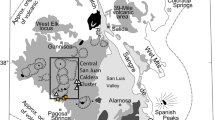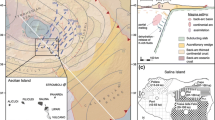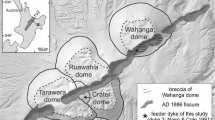Abstract
Spinifex-textured komatiites at Honeymoon Well, Western Australia, show evidence of partial melting and recrystallization of original igneous textures. Their textures and mineral compositions differ markedly from those typical of komatiites. Spinifex olivine plates are bent and broken, while interstitial space between spinifex and cumulus olivine is occupied by polygonal aggregates of clinopyroxene, orthopyroxene, minor olivine and plagioclase. Similar granular pyroxene-plagioclase aggregates occur as diffuse veins cutting spinifex zones and cumulate zones of the flows and, in places, form the matrix to a breccia containing corroded fragments of spinifex rock. Thermometry based on the two pyroxene assemblages yields temperatures of 1055° to 1141° C, just below the low-pressure komatiite solidus. Mineral compositions are different from those of typical komatiites: clinopyroxenes are Al-poor and Cr-rich, olivines are unusually iron-rich and depleted in Cr and Ca, and the low-Ca pyroxene is bronzite rather than the more typical pigeonite. We interpret these observations as the results of thermal metamorphism, partial remelting and subsequent slow crystallization of originally normal spinifex-textured komatiite flows. The rocks in question occupy a 40–70 m interval sandwiched between two olivine-rich units: an underlying 90 m-thick olivine adcumulate layer, forming part of the cumulate zone of a basal 160 m-thick flow, and an overlying 1 km-thick extrusive body composed mostly of olivine mesocumulate and adcumulate and capped in turn by spinifex-textured flows. Thermal modelling shows that a sinusoidal temperature profile of cool flow tops and hot flow centres would exist within this sequence shortly after eruption. Conductive thermal relaxation of this profile could reheat spinifex zones to the extent of inducing partial melting and textural reconstitution. Such reheating is largely dependent on the time interval between the emplacement of successive flows. Calculations suggest that at Honeymoon Well the emplacement interval must have been of the order of 10 years or less. Textural reconstitution may have contributed to the development of the thick orthocumulate sequences characteristic of komatiites in the Agnew-Wiluna belt.
Similar content being viewed by others
References
Arndt NT (1976) Melting relations of ultramafic lavas (komatiites) at 1 atm and high pressure. Carnegie Inst Washington Yearb 75:555–562
Arndt NT (1986) Differentiation of komatiite flows. J Petrol 27:279–303
Arndt NT, Fleet ME (1979) Stable and metastable pyroxene crystallization in layered komatiite lava flows. Am Mineral 64:856–864
Arndt NT, Naldrett AJ, Pyke DR (1977) Komatiitic and iron-rich tholeiitic lavas of Munro Township, northeast Ontario. J Petrol 18:319–369
Barnes S-J (1985) The petrography and geochemistry of komatiite flows from the Abitibi greenstone belt and a model for their formation. Lithos 18:241–270
Barnes S-J, Gorton MP, Naldrett AJ (1983) A comparative study of olivine and clinopyroxene spinifex flows from Alexo, Abitibi greenstone belt, Ontario, Canada. Contrib Mineral Petrol 83:292–308
Barnes S-J, Hill RET, Gole MJ (1988) The Perseverance ultramafic complex, Western Australia: the product of a komatiite lava river. J Petrol 29:305–331
Binns RA, Hallberg JA, Taplin JH (1982) Komatiites in the Yilgarn Block, Western Australia. In: Arndt NT, Nisbet EG (eds) Komatiites. Allen and Unwin, London, pp 117–130
Carslaw HS, Jaeger JC (1959) Conduction of heat in solids. Oxford University Press, New York
Davidson PM, Lindsley DH (1985) Thermodynamic analysis of quadrilateral pyroxenes Part II: model calibration from experiments and applications to geothermometry. Contrib Mineral Petrol 91:390–404
Donaldson CH (1982) Spinifex-textured komatiites: a review of textures, compositions and layering. In: Arndt NT, Nisbet EG (eds) Komatiites. Allen and Unwin, London, pp 213–244
Donaldson MJ, Bromley GJ (1981) The Honeymoon Well nickel sulfide deposits. Western Australia. Econ Geol 76:1550–1564
Donaldson MJ, Lesher CM, Groves DI, Gresham JJ (1986) Comparison of Archaean dunites and komatiites associated with nickel mineralisation in Western Australia: implications for dunite genesis. Miner Deposita 21:296–305
Echeverria LM (1980) Tertiary or Mesozoic komatiites from Gorgona Island, Colombia: field relations and geochemistry. Contrib Mineral Petrol 73:253–266
Evans BE, Trommsdroff V (1974) On elongate olivine of metamorphic origin. Geology 1:131–132
Groves DI, Korkiakoski EA, McNaughton NJ, Lesher CM, Cowden A (1986) Thermal erosion by komatiites at Kambalda, Western Australia, and the genesis of nickel ores. Nature 319:136–139
Hill RET, Gole MJ, Barnes SJ (1987) Physical volcanology of komatiites — a field guide to the komatiites between Kalgoorlie and Wiluna, Eastern Goldfields Province, Yilgarn Block, Western Australia (Excursion Guide Book). Geological Society of Australia, Western Australia Division
Hill RET, Gole MJ, Barnes SJ (1989) Olivine adcumulates in the Norseman-Wiluna greenstone belt, Western Australia: implications for the volcanology of komatiites. In: Prendergast MD, Jones MJ (eds) Magmatic sulphides — the Zimbabwe volume. Institute of Mining Metall, London, pp 189–206
Huppert HE, Sparks RSJ, Arndt NT (1984) Emplacement and cooling of komatiitic lavas. Nature 309:19–22
Naldrett AJ, Turner AR (1977) The geology and petrogenesis of a greenstone belt and related nickel sulphide mineralization at Yakabindie, Western Australia. Precambrian Res 7:3–30
Nisbet EG, Bickle MJ, Martin A (1977) The mafic and ultramafic lavas of the Belingwe greenstone belt, Rhodesia. J Petrol 18:521–566
Nisbet EG, Arndt NT, Bickle MJ, Cameron WE, Chauvel C, Cheadle M, Hegner E, Kyser TK, Martin A, Renner R, Roedder E (1987) Uniquely fresh 2.7 Ga komatiites from the Belingwe greenstone belt, Zimbabwe Geology 15:1147–1150
Smith HS, Erlank AJ (1982) Geochemistry and petrogenesis of komatiites from the Barberton greenstone belt, South Africa. In: Arndt NT, Nisbet EG (eds) Komatiites. Allen and Unwin, London, pp 347–397
Turner JS, Huppert HE, Sparks RSJ (1986) Komatiites. II. Experimental and theoretical investigations of post-emplacement cooling and crystallization. J Petrol 27:397–437
Wells PRA (1977) Pyroxene thermometry in simple and complex systems. Contrib Mineral Petrol 62:129–139
Author information
Authors and Affiliations
Additional information
Present address: Geochemex Australia, P.O. Box 281, West Perth, 6005, Western Australia
Rights and permissions
About this article
Cite this article
Gole, M.J., Barnes, S.J. & Hill, R.E.T. Partial melting and recrystallization of Archeaan komatiites by residual heat from rapidly accumulated flows. Contr. Mineral. and Petrol. 105, 704–714 (1990). https://doi.org/10.1007/BF00306535
Received:
Accepted:
Issue Date:
DOI: https://doi.org/10.1007/BF00306535




